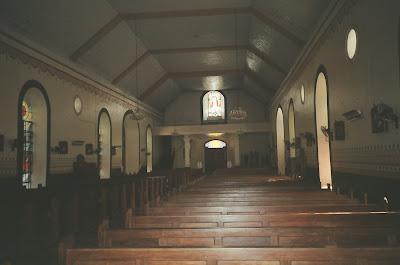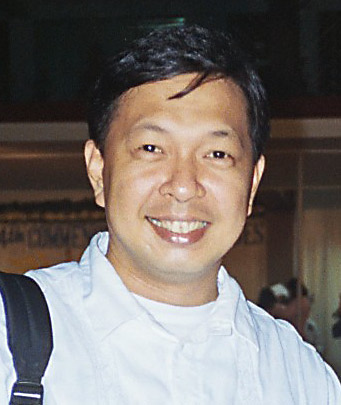
On top of the hill - Beside the Rizal statue

Day 5 - Our penultimate day in Abra gave me some free time in the morning for some sight-seeing and pasalubong shopping.
The postponed opening of bids yesterday at the Abra DEO reset for today was again mysteriously moved for Monday. We felt that move was highly suspicious to say the least considering they knew we were joining the CCAGG observers. Moving it to next week assured them that we would not be present anymore during their initial proceedings.

Making the most of our new found free time, I took the opportunity to visit one of the most famous spots in Bangued - the Victoria National Park. The park is located atop a hill overlooking the town of Bangued and neighboring municipalities of Tayum, La Paz, Pidigan and Peňarrubia. A shrine of the Blessed Mother Mary holding the Infant Jesus was built near a reservoir of Bangued waterworks. A swimming pool is also available for swimmers.
 The Victoria Park sign post’s decrepit condition reflects the park’s inadequate maintenance and decay
The Victoria Park sign post’s decrepit condition reflects the park’s inadequate maintenance and decay It’s a place with a scenic view but is deficient in the most basic amenities like park chairs
It’s a place with a scenic view but is deficient in the most basic amenities like park chairs The Abra river can be seen from afar
The Abra river can be seen from afar
After we went back for Perry and had lunch at a nearby hotel’s restaurant, we bought additional items at the ADTEMPCO Coopmart near the Pastoral Center.
I bought another bottle of honey, two packs of Yema (it was a hard candy version) and a native delicacy, the Balikutsa or Balicutcha. This very sweet hard candy is derived from sugarcane.
Later that afternoon, Perry and I met with CCAGG Chairperson Pura Sumangil where she updated us with the latest activities of the NLCGG and the CCAGG. These activities included the World Bank funded “Road Watch (Bantay Lansangan) Project and a “Pre-Election Activities Training Program.”
We thanked Manang Pura and the CCAGG staff today for their warm welcome, assistance and cooperation on this study knowing we may not be able to see them tomorrow morning as we headed back for Manila.
March 6 - Last day in Abra
 The Pastoral Center’s Conference Hall near our sleeping quarters at the third floor
The Pastoral Center’s Conference Hall near our sleeping quarters at the third floor The youth prepare for an upcoming festivity
The youth prepare for an upcoming festivity
We left Bangued at around 9:15 a.m.
My planned courtesy call to Bishop Jaucian this morning again fizzled out. If I remember right I was told that he was in Manila.
At any rate, I was able to pass by the Bulda residence in Bangued and personally meet Bro. Moding and Sis. Glo Bulda, our CFC Provincial leaders in Abra and bid them farewell.
 With Bro. Moding Bulda and his two grandchildren Kristine Coleen Ballestra and Farelle Baroňa
With Bro. Moding Bulda and his two grandchildren Kristine Coleen Ballestra and Farelle BaroňaOn our way home, we again passed by Perry’s parents in Candon City, Ilocos Sur, had lunch at an eatery in Rosario, La Union and stopped over places like the Villasis Public Market in Pangasinan to buy some mangoes and garlic. We later took a different route (longer but less traffic) which brought us through Camiling, Tarlac. Somewhere thereabout, we again stopped over for an irresistible round of cheap halo-halo. In Abra, as well as in the other provinces, we saw dozens of tables beside the streets selling halo-halo. The halo-halo we ate was quite the simple version with mostly crushed ice, evaporated milk and a few other ingredients. But the summer heat has a way of making a simple desert so delectable!
Looking back, there were other numerous points of interest we didn’t get the chance to see in Abra. Places like the Libtec underground river in Dolores or the Kimkimay Lake in Taquib, Villaviciosa supposedly a favorite area for town picnickers who go there to swim and fish as well. Next time.

Some have envisioned the province of Abra to be developed as a northern “Gateway to the Cordilleras”. With its rich cultural and historical heritage, I believe this will be very possible. However, local politicians have to come together abandoning their violent ways and rise up above their political partisanship to work for a peaceful and progressive Abra. More importantly, I believe that the vast majority of the people in Abra are peace loving and upright. In the end, it would be their continued vigilance as seen in the volunteerism spirit of CCAGG that would bring lasting peace and prosperity to this rugged paradise.




 The provincial seal of Abra
The provincial seal of Abra
 Facade of the St. James the Elder Church
Facade of the St. James the Elder Church  At the side of the church is the Holy Spirit Academy and
At the side of the church is the Holy Spirit Academy and

 The DZPA building: Home to the CCAGG
The DZPA building: Home to the CCAGG








 CCAGG volunteers inspect the concrete roads for compliance to building standards
CCAGG volunteers inspect the concrete roads for compliance to building standards
 Half-way through
Half-way through
 Talledo’s is the home of quality miki and canton noodles
Talledo’s is the home of quality miki and canton noodles Definitely a must buy for ‘pasalubong’ (homeward bound treats) seekers
Definitely a must buy for ‘pasalubong’ (homeward bound treats) seekers
 Children near the CCAGG office play war games
Children near the CCAGG office play war games 

 Children enjoy the cool waters
Children enjoy the cool waters


















 Crossing the river
Crossing the river







 Vegetables with ‘bagoong’ never looked so delicious
Vegetables with ‘bagoong’ never looked so delicious


